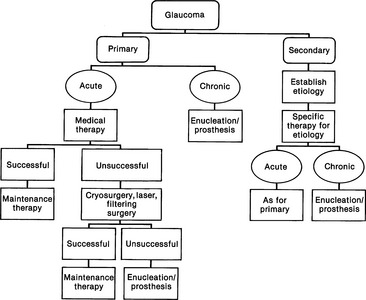Chapter 137 Glaucoma
Glaucoma is an increase in the intraocular pressure (IOP) beyond that compatible with maintenance of normal ocular physiology and function.
ETIOLOGY
Primary Glaucoma
Primary glaucoma is not associated with any other event or problem within the eye. It is usually breed related and often hereditary in nature. A partial list of predisposed breeds is given in Table 137-1.
Secondary Glaucoma
CLINICAL SIGNS
Table 137-2 CLINICAL SIGNS OF ACUTE GLAUCOMA
Slow to absent pupillary light response
Weak to absent menace response
DIAGNOSIS
TREATMENT
In order to treat glaucoma appropriately, answer two specific questions (Fig. 137-1). Is the glaucoma primary or secondary? Is the glaucoma acute or chronic?
Medical
Medical therapy of acute glaucoma includes some, or possibly all, of the following agents (Table 137-4). The choice of medication varies according to the severity of the glaucoma, the etiology, and the response to the initial therapy.
Table 137-4 MEDICAL TREATMENT OF ACUTE GLAUCOMA
| Drug/Concentration | Trade Name | Dose |
|---|---|---|
| Systemic | ||
| Osmotic Drugs | ||
| Mannitol | 0.5–1.0 g/kg, IV | |
| Carbonic Anhydrase Inhibitors | ||
| Dichlorphenamide | Daranide | 2–4 mg/kg, q8–12h, PO |
| Methazolamide | Neptazane | 2–4 mg/kg, q8–12h, PO |
| Topical | ||
| Carbonic Anhydrase Inhibitors | ||
| Dorzolamide 2% | Trusopt | q8–12h |
| Dorzolamide 2%:timolol 0.5% | Cosopt | q8–12h |
| Parasympathomimetics | ||
| Pilocarpine 2% | Isopto Carpine | q8–12h |
| Sympathomimetics | ||
| Epinephrine 1% | q8–12h | |
| Dipivefrin HCl 0.1% | Propine | q8–12h |
| Combination | ||
| Pilocarpine 2%:epinephrine 1% | E-Pilo-2 | q8–12h |
| Sympatholytics | ||
| Timolol maleate 0.5% | Timoptic | q8–12h |
| Prostaglandins | ||
| Latanoprost 0.005% | Xalatan | q12–24h |
Osmotic Drugs
Stay updated, free articles. Join our Telegram channel

Full access? Get Clinical Tree



